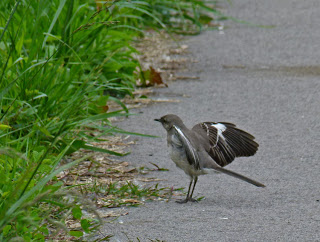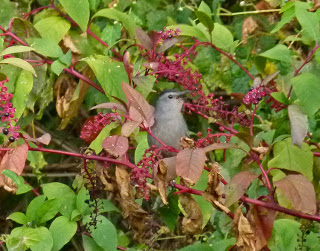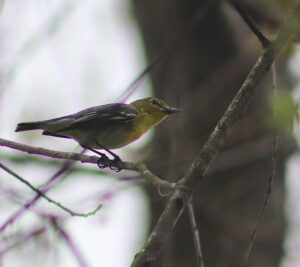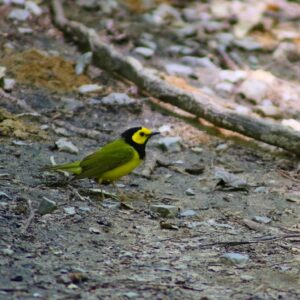
If you have Mockingbirds at home, you know they can be quite aggressive. Mine will chase all the other birds away from the feeder when he’s hungry, or even if he isn’t hungry. After all, it’s a matter of territorial rights! Occasionally a Mockingbird will stand on the ground, and raise his wings up for a bit, then put them down again. I call it the Batman move, as if Batman is holding his cape out. The theory for this behavior is that the shade under his wings fools insects into coming out to be eaten. It’s a good opportunity for the bird watcher to see the bold white wingbars while the bird stands still. Mockingbirds have also been know to imitate cell phone rings, so don’t be surprised to answer your phone and have no one there.
The Gray Catbird gives a long, irregular succession of musical and mechanical notes and phrases, but listen for the cat-like mewing. Sometimes it seems to mimic other birds. This bird is often seen in suburban gardens where It forages mainly on the ground, gleaning insects from litter and low bushes and eating fallen berries during late summer and fall. It does not uncover litter with its feet like a sparrow but pokes with its bill, turning leaves and twigs to find the food underneath. Formerly known simply as the “Catbird,” this bird has had its name changed officially to Gray Catbird because there is an all-black species, the Black Catbird, in southern Mexico. (After all, we don’t want anyone in Kentucky to get confused, now, do we?) It often announces its presence by a harsh, cat-like whine issuing from a dense tangle of vegetation; the bird responds to an imitation of this call, popping suddenly into view for a better look.
Although sometimes disliked because they chase smaller birds away from feeders, Blue Jays are among the handsomest of birds. They often bury seeds and acorns, and since many are never retrieved they are, in effect, tree planters. They regularly mob predators, and their raucous screaming makes it easy to locate a hawk or a roosting owl. Although seen all year, they are migratory and travel in large loose flocks in spring and fall. They make raucous jay-jay, harsh cries, and a rich variety of other calls. One is almost identical to the scream of the Red-shouldered Hawk, and suckers me in every time! I remember the more musical tweedle-dee call from my grandmother’s farm as a child.






